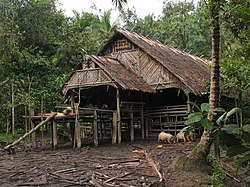
Sumatra is one of the Sunda Islands of western Indonesia. It is the largest island that is fully within Indonesian territory, as well as the sixth-largest island in the world at 473,481 km2 (182,812 mi.2), not including adjacent islands such as the Simeulue, Nias, Mentawai, Enggano, Riau Islands, Bangka Belitung and Krakatoa archipelago.

West Sumatra is a province of Indonesia. It is located on the west coast of the island of Sumatra and includes the Mentawai Islands off that coast. The province has an area of 42,012.89 km2, with a population of 5,534,472 at the 2020 census. The official estimate as at mid 2021 was 5,580,232. West Sumatra borders the Indian Ocean to the west, as well as the provinces of North Sumatra to the north, Riau to the northeast, Jambi to the southeast, and Bengkulu to the south. The province is subdivided into twelve regencies and seven cities. It has relatively more cities than other provinces outside of Java, although several of them are relatively low in population compared with cities elsewhere in Indonesia. Padang is the province's capital and largest city.

The Mentawai Islands Regency are a chain of about seventy islands and islets approximately 150 kilometres off the western coast of Sumatra in Indonesia. They cover 6,033.76 km2 and had a population of 76,173 at the 2010 Census and 87,623 at the 2020 Census. Siberut at 3,838.25 square kilometres is the largest of the islands. The other major islands are Sipura, North Pagai, and South Pagai. The islands lie off the Sumatran coast, across the Mentawai Strait. The indigenous inhabitants of the islands are known as the Mentawai people. The Mentawai Islands have become a noted destination for surfing, with over 40 boats offering surf charters to international guests.
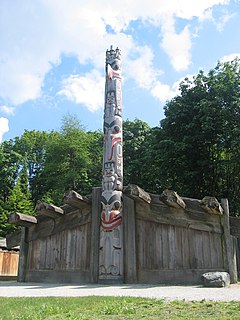
A longhouse or long house is a type of long, proportionately narrow, single-room building for communal dwelling. It has been built in various parts of the world including Asia, Europe, and North America.

Vernacular architecture is building done outside any academic tradition, and without professional guidance. This category encompasses a wide range and variety of building types, with differing methods of construction, from around the world, both historical and extant, representing the majority of buildings and settlements created in pre-industrial societies. Vernacular architecture constitutes 95% of the world's built environment, as estimated in 1995 by Amos Rapoport, as measured against the small percentage of new buildings every year designed by architects and built by engineers.
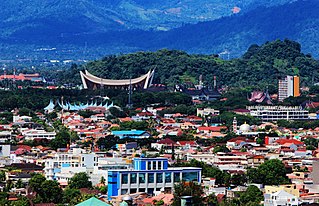
Padang is the capital and largest city of the Indonesian province of West Sumatra. With a Census population of 909,040 as of 2020, it is the 16th most populous city in Indonesia and the most populous city on the west coast of Sumatra. The Padang metropolitan area is the third most populous metropolitan area in Sumatra with a population of over 1.4 million. Padang is widely known for its Minangkabau culture, cuisine, and sunset beaches.

Malay houses refer to the vernacular dwellings of the Malays, an ethno-linguistic group inhabiting Sumatra, coastal Borneo and the Malay Peninsula.

Rumah Gadang or Rumah Bagonjong "house for the Minangkabau people" are the traditional homes of the Minangkabau in West Sumatra, Indonesia. The architecture, construction, internal and external decoration, and the functions of the house reflect the culture and values of the Minangkabau. A Rumah Gadang serves as a residence, a hall for family meetings, and for ceremonial activities. In the matrilineal Minangkabau society, the Rumah Gadang is owned by the women of the family who live there; ownership is passed from mother to daughter.

Mentawai people are the native people of the Mentawai Islands about 100 miles from West Sumatra province, Indonesia. They live a semi-nomadic hunter-gatherer lifestyle in the coastal and rainforest environments of the islands and are also one of the oldest tribes in Indonesia. The Mentawai population is estimated to be about 64,000. The Mentawai tribe is documented to have migrated from Nias – a northern island – to the Mentawai islands, living in an isolated life for centuries until they encountered the Dutch in 1621. The ancestors of the indigenous Mentawai people are believed to have first migrated to the region somewhere between 2000 to 500 BCE. The Mentawai language belongs to the Austronesian language family. They follow their own animist belief system called Arat Sabulungan, that links the supernatural powers of ancestral spirits to the ecology of the rainforest. When the spirits are not treated well or forgotten, they might bring bad luck like illnesses and haunt those who forgot them. Mentawai also have very strong belief towards objects they think are holy. The people are characterized by their heavy spirituality, body art and their tendency to sharpen their teeth, a practice they feel makes one beautiful. Mentawai tend to live in unison and peace with the nature around them because they believe that all things in nature have some kind of spiritual essence.

The architecture of Indonesia reflects the diversity of cultural, historical and geographic influences that have shaped Indonesia as a whole. Invaders, colonizers, missionaries, merchants and traders brought cultural changes that had a profound effect on building styles and techniques.
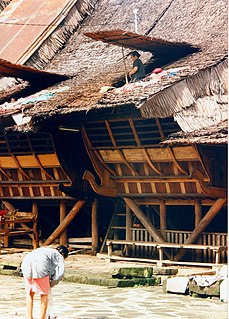
The Omo sebua is a traditional house style of the Nias people from Nias island, Indonesia. They are built only for the houses of village's chiefs. Situated in the centre of a village, omo sebua are built on massive ironwood piles and have towering roofs. Nias culture, with former frequent inter-village warfare, has made the design of omo sebua impregnable to attack. The houses' sole access is through a narrow staircase with a small trap door above. The steeply pitched roofs can reach 16 metres in height. Apart from a strong defense against enemies, omo sebua have proven earthquake resistance.

The 2010 Mentawai earthquake occurred with a moment magnitude of 7.8 on 25 October off the western coast of Sumatra at 21:42 local time. The earthquake occurred on the same fault that produced the 2004 Indian Ocean earthquake. It was widely felt across the provinces of Bengkulu and West Sumatra and resulted in a substantial localized tsunami that struck the Mentawai Islands.
Reimar Schefold, is professor emeritus of cultural anthropology and sociology of Indonesia at Leiden University. His special interests are thematic symbolic anthropology, cultural materialism, vernacular architecture, and social change among ethnic minorities. He has lectured and written about diversity and commonality amongst the inhabitants of the islands off the coast of West Sumatra.

The Sakuddei or Sabiroet people are an ethnic group, one of at least eleven, on the island of Siberut, Indonesia. Siberut is the northernmost of the Mentawai Islands which are located 130 km (81 mi) to the west off the coast of Sumatra. The Sakuddei live in south-central Siberut in an egalitarian society, cut off from the outside world. They speak a dialect of the Malayo-Polynesian Mentawai language.
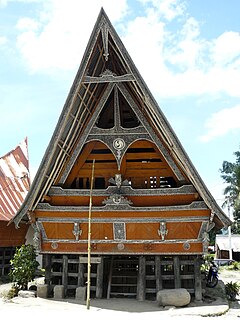
Batak architecture refers to the related architectural traditions and designs of the various Batak peoples of North Sumatra, Indonesia. There are six groups of Batak who speak separate but related languages: the Angkola, the Mandailing to the south, the Toba, to the north the Pakpak/Dairi, the Simalungun, and the Karo. While the groups are now Muslim or Christian, elements of the ancient Batak religion remain, particularly amongst the Karo.

The Indonesian island of Sumatra is the sixth largest island in the world. The rich ethnic diversity and historical heritage in Sumatra is reflected in the range of architectural styles in the island. The vernacular style is the native Sumatran ethnic groups architecture of dwellings, while the Hindu-Buddhist architecture reflected through the cultural historical heritage of candis built in Sumatra. The third wave is Islamic architecture adopted in mosques and palace in Sumatra, especially in Aceh, North Sumatra, and Malay cultural sphere in the island.

Rumah adat are traditional houses built in any of the vernacular architecture styles of Indonesia, collectively belonging to the Austronesian architecture. The traditional houses and settlements of the several hundreds ethnic groups of Indonesia are extremely varied and all have their own specific history. It is the Indonesian variants of the whole Austronesian architecture found all over places where Austronesian people inhabited from the Pacific to Madagascar each having their own history, culture and style.
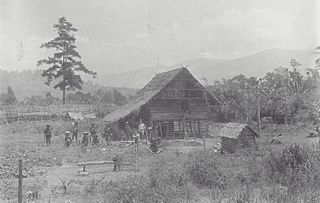
An uma is the traditional house of the Gajo district which borders Aceh on the Indonesian island of Sumatra.
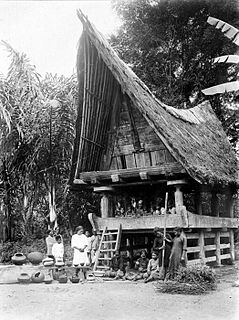
A sopo is a treasury structure in the architecture of the Toba Batak people from North Sumatra, Indonesia. Its form is similar to that of a Batak traditional house with the exception of being smaller in size and a construction ritual that is the opposite of a Batak house. Sopo is used as a repository for various items, e.g. rice, magical items, or trophies. Sopo can also be used as a meeting point for social activities.
